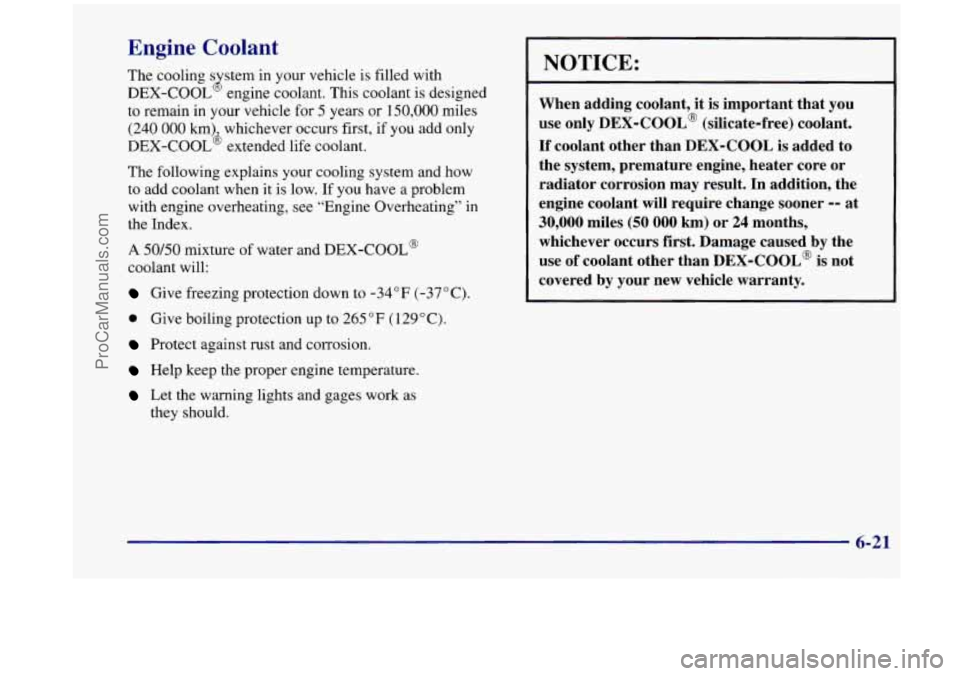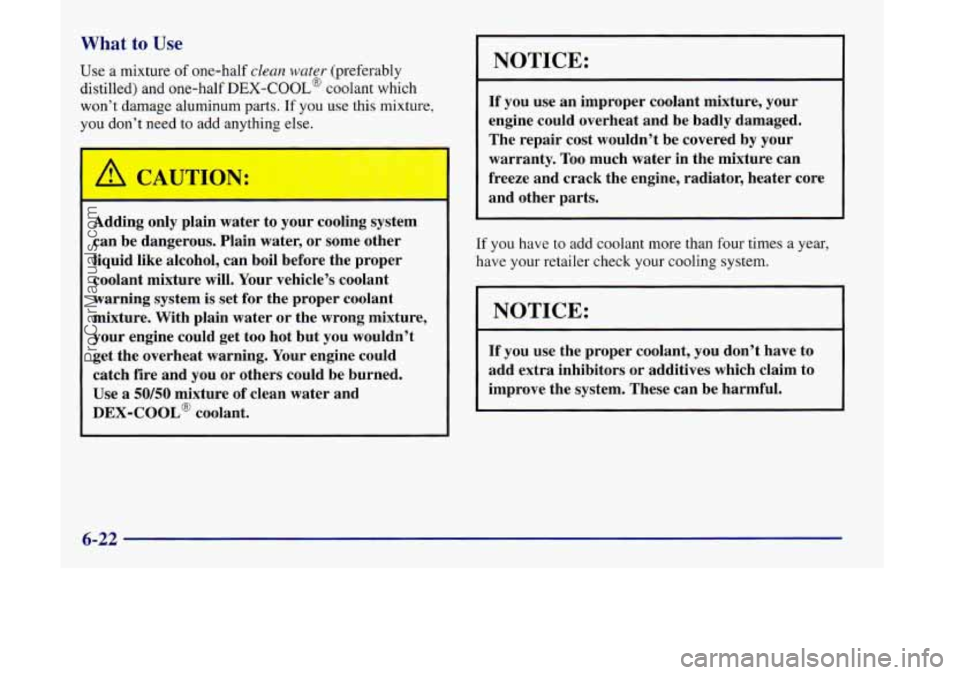Page 325 of 444

If none of them is true, use the long triphighway
maintenance schedule. Change the oil and filter every
7,500 miles (12 500 km) or 12 months -- whichever
occurs first. Driving a vehicle with a fully warmed
engine under highway conditions causes engine oil to
break down slower.
What to Do with Used Oil
Did you know that used engine oil contains certain
elements that may be unhealthy for your skin and could
even cause cancer? Don’t let used oil stay on your
skin
for very long. Clean your skin and nails with soap and
water, or a good hand cleaner. Wash or properly throw
away clothing or rags containing used engine oil. (See
the manufacturer’s warnings about the use and disposal
of oil products.)
Used oil can be a real threat to the environment. If you
change your own oil, be sure to drain all free-flowing oil
from the filter before disposal. Don’t ever dispose of
oil
by putting it in the trash, pouring it on the ground, into
sewers, or into streams or bodies of water. Instead,
recycle it by taking it to a place that collects used oil.
If
you have a problem properly disposing of your used oil,
ask your retailer, a service station or a local recycling
center for help.
Air Cleaner
The air cleaner is located at the front of the engine
compartment (on the driver’s side of the vehicle), under
the engine coolant reservoir.
6-15
ProCarManuals.com
Page 331 of 444

Engine Coolant
The cooling s stem in your vehicle is filled with
DEX-COOL engine coolant. This coolant is designed
to remain in your vehicle for
5 years or 150,000 miles
(240 000 lunb whichever occurs first, if you add only
DEX-COOL extended life coolant.
J
The following explains your cooling system and how
to add coolant when it is low. If you have a problem
with engine overheating, see “Engine Overheating” in
the Index.
A 50/50 mixture of water and DEX-COOL@
coolant will:
Give freezing protection down to -34°F (-37°C).
0 Give boiling protection up to 265 OF (1 29 O C).
Protect against rust and corrosion.
Help keep the proper engine temperature.
Let the warning lights and gages work as
they should.
NOTICE:
When adding coolant, it is important that you
use only
DEX-COOL@ (silicate-free) coolant.
If coolant other than DEX-COOL is added to
the system, premature engine, heater core or
radiator corrosion may result. In addition, the
engine coolant will require change sooner
-- at
30,000 miles (50 000 km) or 24 months,
whichever occurs
first. Damage caused by the
use of coolant other than DEX-COOL@ is not
covered by your new vehicle warranty.
6-21
ProCarManuals.com
Page 332 of 444

What to Use
Use a mixture of one-half clean water (preferably
distilled) and one-half
DEX-COOL@ coolant which
won’t damage aluminum parts. If you use this mixture,
you don’t need to add anything else.
Adding only plain water to your cooling system
can be dangerous. Plain water, or some other
liquid like alcohol, can boil before the proper coolant mixture will. Your vehicle’s coolant
warning system is set for the proper coolant
mixture. With plain water or the wrong mixture,
your engine could get too hot but you wouldn’t
get the overheat warning. Your engine could
catch fire and you or others could be burned.
Use
a 50/50 mixture of clean water and
DEX-COOL@ coolant.
J
NOTICE:
If you use an improper coolant mixture, your
engine could overheat and be badly damaged.
The repair cost wouldn’t be covered by your
warranty. Too much water in the mixture can
freeze and crack the engine, radiator, heater core
and other parts.
If you have to add coolant more than four times a year,
have your retailer check your cooling system.
NOTICE:
If you use the proper coolant, you don’t have to
add extra inhibitors or additives which claim to
improve the system. These can be harmful.
6-22
ProCarManuals.com
Page 333 of 444
Checking Coolant
The engine coolant reservoir is located on the driver’s
side
of the vehicle, above the air cleaner.
When your engine
is cold, the coolant level should be
at
FULL COLD, or a little higher. When your engine
is warm, the level should be above the
FULL COLD
mark, or a little higher.
Adding Coolant
If this light comes on, it
means you’re low on
engine coolant.
If you need more coolant, add the proper DEX-COOL@
coolant mixture at the coolant recovery tank.
-
Turning the radiator pressure cap when the
engine and radiator are hot can allow steam and
scalding liquids to blow out and burn you badly.
With the coolant recovery tank, you will almost
never have
to add coolant at the radiator. Never
turn the radiator pressure cap
-- even a little --
when the engine and radiator are hot.
6-23
ProCarManuals.com
Page 334 of 444
1 Add coolant mixture at the recovery tank, but be careful
~ not to spill it.
~
You can be burned if you spill coolant on hot
engine parts. Coolant contains ethylene glycol,
and
it will burn if the engine parts are hot
enough. Don’t spill coolant on
a hot engine.
_- -
When you replace your radiator pressure cap, a GM cap
is recommended.
Radiator Pressure Cap
NOTICE:
Your radiator cap is a 15 psi (105 kPa)
pressure-type cap and must be tightly installed to
prevent coolant loss and possible engine damage
from overheating. Be
sure the arrows on the cap
line up with the overflow tube on the radiator
filler neck.
Thermostat
Engine coolant temperature is controlled by a thermostat
in the engine coolant system. The thermostat
stops the
flow of coolant through the radiator until the coolant
reaches a preset temperature.
When you replace your thermostat, a
GM thermostat
is recommended.
1 6-24
I I
ProCarManuals.com
Page 336 of 444

Windshield Washer Fluid
What to Use
When you need windshield washer fluid, be sure to read
the manufacturer’s instructions before use. If you will
be
operating your vehicle in an area where the temperature
may fall below freezing, use a fluid that has sufficient
protection against freezing.
Adding Washer Fluid
The windshield washer
fluid reservoir is located on
the passenger’s side
of the
vehicle, near the fuse and
relay center.
NOTICE:
Open the cap labeled WASHER FLUID ONLY. Add
washer fluid until the tank
is full.
0
0
0
0
When using concentrated washer fluid,
follow the manufacturer’s instructions for
adding water.
Don’t mix water with ready-to-use washer
fluid. Water can cause the solution to freeze and damage your washer fluid tank and
other parts of the washer system.
Also,
water doesn’t clean as well as washer fluid.
Fill your washer fluid tank only
three-quarters full when it’s very cold.
This allows
for expansion if freezing occurs,
which could damage the tank if it is
completely full.
Don’t use engine coolant (antifreeze) in
your windshield washer. It can damage
your washer system and paint.
6-26
ProCarManuals.com
Page 371 of 444

Underhood Fuse and Relay Center
This fuse and relay center is located in the engine
compartment, in front
of the windshield washer
fluid reservoir.
The fuses marked spare are available
if a replacement
fuse is needed.
‘ MAXIFUSES 1 ~ COOL FAN 2 :30 A)
3 - HEACLAlvlPS (60 A1 4 8All MAIN 2 (60 A) 5 - lLiN MAIN 1 (40 AI fi - COOL FAN 1 (30 A) 7 - BAlT MAIN 1 !63 A) I3 - IGN MAIN 2 160 AI MINI RELAYS
10 -COOL FAN 2 9 -COOL FAN
12-COOL FAN
1 li IGNMAIN
MICRO RELAYS
IS-FPMPSPDCON~ lG ~- HORN I7 FOGLAMP
MINIFUSES .a- Iru (IO A) ’9 -$=ARE 20 SPARE 21 - lGNi - UH :’5 A) =-SPARE 23 SPARE 21 -SPARE
25-ELEKIGN (l5Aj 26 SPARE 27- BiU LAMP (10 A) 28 - AIC CLU I10 A!
32 FUEL PUMP ;15 AI
33-ECMSENSEilOA) - ’ 34 - 35-FOG LP IlOA) I I 36 HORN (15 A] 37 -PARK LP (20 A) 39 - 38 - II
II
II
DIODES *- AC CLU DIODE
40-MINI FUSEPULLER 1 I
13-AiCCLU 1L - FUEL PUMP 29 - RACCO :la A] 30 ALT SENSE (10 A) L-J 31 --CC (10 A)
Maxi Fuse
1 -COOL FAN 2
3-HEADLAMPS
4-BATT MAIN
2
Coolant Fans
Circuit Breakers: FRT HVAC
HI BLWR, and HEADLAMP
Fuses (UP): HAZARD and
STOPLAMP
Circuit Breaker: PWR
SEATPSD. Fuses
(UP): ELC
and
RR DEFOG
6-61
ProCarManuals.com
Page 396 of 444

1 Short Trip/City Maintenance Schedule I
POS,OOO Miles (166 000 km)
Inspect spark plug wires. An Emission Control Service.
0 Replace spark plugs. An Emission Control Service.
0 Change automatic transaxle fluid and filter if the vehicle is mainly driven
under
one or more of these conditions:
- In heavy city traffic where the outside temperature regularly reaches 90°F
(32 O C) or higher.
- In hilly or mountainous terrain.
- When doing frequent trailer towing.
- Uses such as found in taxi, police or delivery service.
If you do not use your vehicle under any of these conditions, the fluid and
filter
do not require changing.
150,000 Miles (240 000 km)
0 Drain, flush and refill cooling system (or every 60 months since last service,
whichever occurs first). See “Engine Coolant” in the Index for what to
use.
Inspect hoses. Clean radiator, condenser, pressure cap and neck. Pressure test
cooling system and pressure cap.
An Emission Control Service.
DATE
I MILEAGE ACTUAL I SERVICEDBY: I
DATE 1
MILEAGE
ACTUAL SERVICED BY:
7-20
ProCarManuals.com